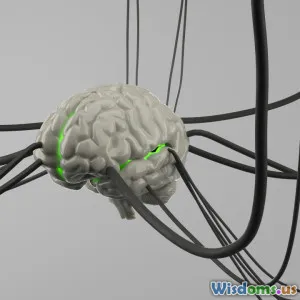
Step by Step Guide to Sharpening Working Memory
15 min read Discover actionable steps to enhance your working memory for better focus, learning, and performance in daily life. (0 Reviews)
Step By Step Guide to Sharpening Working Memory
Working memory is the brain's temporary workspace—a mental notepad where you hold, combine, and manipulate information. Whether you’re managing complex projects, navigating daily life, or learning a new skill, a sharper working memory can boost productivity and confidence. While some working memory capacity is inherited, science shows that it can also be cultivated and strengthened. In this guide, we’ll unravel practical, evidence-based strategies to sharpen your working memory step by step.
Understanding Working Memory

Think of working memory as the cognitive equivalent of your computer’s RAM. It briefly holds the data you need for reasoning, problem-solving, and decision-making. Psychologist Alan Baddeley’s famous model splits working memory into components: a phonological loop for sound and language, a visuospatial sketchpad for images and space, and a central executive for turning both into coherent decisions.
For example, when you’re recalling a phone number long enough to dial it or follow verbal instructions to assemble furniture, you’re relying on working memory. Deficits can manifest as lost trains of thought, difficulty following conversations, or trouble learning new information—problems common across all ages.
Recent studies underscore how crucial working memory is, with larger capacities linked to stronger academic performance, greater career achievement, and even emotional resilience. The underlying message? Sharpening working memory is a powerful life upgrade.
Identifying Your Personal Starting Point

Before building memory muscle, discover your current strengths and weaknesses. Try simple self-assessment tests:
- Digit Span Test: Listen to a sequence of numbers and repeat it backward. Most adults can accurately manage five to seven items.
- N-Back Task: Remember a stream of letters or locations and signal when something is repeated after a set interval (often 2-3 positions back).
- Everyday Observations: Do you frequently forget what you just read, misplace objects, or have difficulty following spoken directions?
Track performance honestly. Many free cognitive testing apps and websites (such as Cambridge Brain Sciences) can offer an initial baseline. Identifying patterns allows you to customize your memory-improving strategies more effectively.
Minimizing Distractions for Maximum Focus

Distractions are the enemy of working memory. Research from Princeton University found that cluttered spaces and digital overload fragment our attention, choking our short-term retention.
- Create a distraction-free zone: Dedicate work or study areas free from unnecessary objects and visual noise.
- Batch notifications: Silence emails and social media alerts outside of scheduled times to prevent cognitive interruptions.
- Practice single-tasking: Multitasking may seem efficient but dilutes working memory resources. Choose one task, complete it, then move to the next.
Practical changes—like moving your smartphone outside your workspace or closing unused computer tabs—can have a surprising impact. Half an hour of highly focused, undistracted time equals hours of fragmented effort.
Practicing Advanced Attention Techniques

If working memory is the brain’s workbench, advanced attention techniques are the tools that keep it clear and sharp. Mindfulness and meditation, for instance, are scientifically proven to boost attention span and working memory capacity.
- Mindfulness Meditation: Regular sessions (even 10 minutes daily) where you intentionally focus on your breath and redirect wandering thoughts can increase gray matter density in brain regions associated with memory.
- Attentional Control Exercise: Try the "Spot-the-difference" game, or practice reading a page and recalling as many details as possible. Both train your brain’s ability to screen out distractions and retain relevant information.
- Focused Breathing Patterns: Techniques like box breathing (inhale, hold, exhale, hold, each for four seconds) are practical micro-tools for immediate attention restoration in high-stress moments.
Olympic athletes, surgeons, and high-level chess players use variants of these exercises to stay razor-sharp under pressure. Integrate similar rituals into your day for measurable results.
Optimizing Physical Health for Cognitive Boosts

A healthy brain requires proper nourishment—physically as much as mentally. Diet, exercise, hydration, and sleep play foundational roles in working memory optimization.
-
Nutrition: Diets rich in leafy greens, omega-3 fatty acids (like those found in fish and flaxseed), seeds, nuts, and berries are correlated with better memory and cognitive longevity. Limit processed foods, excessive sugar, and alcohol.
A practical example: A 2020 review in Nutrients found that Mediterranean-style diets boosted memory scores in adults aged 50 and up.
-
Exercise: Both resistance training and aerobic activity trigger neurogenesis—the growth of new brain cells. Thirty minutes of brisk walking five days a week can sharpen focus and memory.
-
Sleep: Sleep is when the brain consolidates short-term memories into long-term storage. Chronic sleep loss impairs working memory. Aim for 7-9 quality hours nightly, and set regular sleep-wake times.
-
Hydration: Even mild dehydration can sap concentration and short-term recall. Sip water regularly, especially when focused on intensive cognitive tasks.
Training Memory Through Targeted Exercises

Deliberate, structured practice builds working memory, much like pushups build muscles. Scientific programs such as Cogmed and Lumosity have popularized the concept—though classic methods are just as effective.
Classic Exercises:
- Dual N-Back Games: These have robust research support. They train you to track visual and auditory information simultaneously, improving memory span and reasoning skills.
- Backward Spelling and Counting: Try reciting short sentences or lists backward. This stresses the ‘phonological loop’ and introduces a fun challenge.
- Mental Math: Practice adding or multiplying multi-digit numbers mentally. Enhances both speed and retention.
Everyday Activities:
- Playing Cards: Games like Concentration or even poker help you track sequences and anticipate moves.
- Chess and Strategy Games: Engage multiple memory systems and improve complex decision-making skills.
- Cooking from Memory: Try memorizing a recipe’s steps and ingredients, then cooking without referring back to the instructions.
Experiment with different exercises to keep the brain challenged and entertained, ensuring you don’t plateau with familiar routines.
Chunking and Visualization: Work Smarter, Not Harder
Chunking and visualization strategies are powerful cognitive shortcuts endorsed by memory champions and educators around the globe.
-
Chunking: Decompose information into manageable units. For example, remember a 10-digit phone number by breaking it into three groups instead of one long strand. Or, chunk a to-do list by category (errands, work, home chores).
-
Visualization: Add vivid images to dry facts. If you need to remember a shopping list (milk, apples, toothpaste), try picturing a cow wearing an apple as a hat while brushing its teeth. Humor and extravagance make the memories stick.
-
Mind Maps: Organize complex projects or studies as visual branches radiating from a key topic. This employs spatial memory and creates cognitive landmarks.
Neuroscientific studies confirm that such mnemonic devices reduce the cognitive load on working memory and boost recall accuracy.
Developing Verbal and Auditory Working Memory

Strong auditory working memory is key for language learning, following oral instructions or holding conversations. Here’s how to strengthen it:
- Active Listening: Every day, try to summarize conversations or meeting points in your own words, either mentally or aloud.
- Repeating Aloud: When learning names, new terminology, or instructions, say them back to yourself. This mental rehearsal engages deeper encoding.
- Storytelling Exercises: Start a story, then build it up, one sentence at a time, retaining the narrative and adding appropriate details. Useful in group settings or as a solo challenge.
Teachers use these techniques in classrooms to boost children’s literacy and attention, but they’re equally powerful for adult learners and professionals.
Building Visual-Spatial Working Memory

Some individuals excel at remembering faces, navigation, or diagrams. If you’d like to hone this spatial side of working memory:
- Visual Recall: After leaving a room, picture where objects were located before returning to check your memory.
- Sketching and Map Reading: Practice drawing rough maps of familiar places or recreating geometric patterns by memory.
- Puzzles and Construction: Tetris, Lego, or mechanical puzzles (like tangrams) require organizing shapes and positions in your mental workspace.
Architects, surgeons, artists, and athletes all depend on unusually strong visual-spatial memory—this form is trainable for everyone with the right practice routines.
Leveraging Technology, But Wisely

Modern tools can both help and hurt working memory. Used judiciously, they can scaffold learning and support recall without contributing to digital dependency.
- Apps for Practice: Programs like Elevate, Peak, and Memorado offer daily brain training tailored to your schedule.
- Timers and Planners: Digital calendars and to-do lists can store non-critical details, freeing up brain power for higher-level tasks.
- Alert Overload: Conversely, too many reminders or notifications interrupt focus and erode memory performance. Regularly audit which apps can alert you and ruthlessly disable the rest.
Strive for a mindful balance—integrating digital supports only when they aid, not replace, your cognitive efforts.
Establishing a Lifestyle That Sustains Gains

Much like physical health, exceptional working memory is about consistency rather than intensity. Embrace small, sustainable routines:
- Daily mental workouts: Slot five minutes after lunch for a brain game or memory test, making it as habitual as brushing teeth.
- Sleep and downtime: Support memory consolidation by strictly designating offline hours for quality rest.
- Frequent learning: Take up hobbies that challenge your mind—learning an instrument, a language, or volunteering in roles that demand rapid remembering (like event organizing or teaching).
Athletes warm up and cool down to prevent injury and maximize their edge—the same principle applies to memory routines. Periodically reassess your needs and adapt your strategies. Track improvements, celebrate milestones, and refine habits for enduring success.
Taking the time to strengthen your working memory pays dividends across career, study, and day-to-day life. Integrate these steps gradually, adjusting to your unique goals and progress. With mindful consistency, your mental workspace will not only become sharper, but also more resilient and expansive—equipping you to handle whatever challenges come your way.
Rate the Post
User Reviews
Popular Posts


















